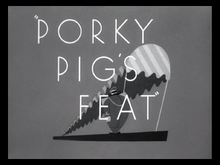Porky Pig's Feat
| Porky Pig's Feat | |
|---|---|
| Looney Tunes (Porky Pig/Daffy Duck) series | |
 Title card | |
| Directed by |
Supervision: Frank Tashlin |
| Produced by | Leon Schlesinger |
| Story by | Melvin Millar |
| Voices by | Mel Blanc |
| Music by | Carl Stalling |
| Animation by |
Phil Monroe Additional animation: Cal Dalton (uncredited) Art Davis (uncredited) Izzy Ellis (uncredited) |
| Studio | Leon Schlesinger Productions |
| Distributed by | Warner Bros. |
| Release date(s) | July 17, 1943 (USA) |
| Color process | Black-and-white |
| Running time | 9 minutes |
| Language | English |
Porky Pig's Feat is a one-reel animated cartoon short subject in the Looney Tunes series, produced in black-and-white and released to theatres on July 17, 1943, by Warner Bros. Pictures. It was directed by Frank Tashlin with musical direction by Carl Stalling, and produced by Leon Schlesinger. Originally released in black-and-white, clips of a digitally colored version of the cartoon were seen in bonus features for the first two Looney Tunes Golden Collection DVD box sets, before finally being issued in its original monochrome form on the Looney Tunes Golden Collection: Volume 3 DVD.
The title is a play on words, referring to "pigs feet."
This was the first Schlesinger cartoon directed by Tashlin after his return to the studio following a five-year absence for stints at the Disney and Screen Gems studios. It is also the only appearance of Bugs Bunny, and final appearance of Porky Pig, in a black-and-white cartoon.
Music
Porky Pig's Feat contains the first use of the music "Powerhouse" in a cartoon.[1] Composed by Raymond Scott, "Powerhouse" became iconic through its use in over forty Warner Bros. cartoons. We also hear "Blues in the Night" after Daffy loses the rent money gambling in the elevator. "The Penguin", another Scott composition, can also be heard when Porky and Daffy run to the elevator with their bags.
Plot
The cartoon centers around Porky Pig and Daffy Duck's attempts to escape the Broken Arms Hotel manager without paying their bill (on which they are charged for every luxury, including breathing air, sunshine, and goodwill); the reason for trying to evade the payment is due to Daffy losing all their money playing craps.
Despite numerous methods to elude the hotel manager (from using the elevator, sending the manager down a large spiral staircase, or going out of the window), he eventually gets the upper hand and locks them up in Porky and Daffy's hotel room until they pay up. Winter approaches, and Daffy is beginning to lose his sanity. Porky (after writing "Porky Loves Petunia" amidst the graffiti on the wall) wishes Bugs Bunny was with them. Daffy concurs and decides to call Bugs for advice, as the trickster is famous for being able to get out of seemingly inescapable situations. While on the phone, Bugs asks Daffy if he's tried various methods of escape, to which Daffy replies that he has. ("Yes, we tried all those ways.") The door to the next room opens up and Bugs is seen in shackles. He says, "Ahh, don't work, do they?"
The cartoon irises out, with the "Porky drum" ending.
Production notes
- This was Bugs Bunny's first appearance in the Looney Tunes series.
- This is the first cartoon where Bugs Bunny says "Eh, what's up duck?" instead of "Eh, what's up, doc?"
- This is Bugs Bunny's only black-and-white appearance in the theatrical cartoons. His later appearances in black-and-white were in some Looney Tunes commercials from the 1960s.
- This cartoon was colorized in 1968 (just after Seven Arts Productions, successor to Guild Films, to whom the black-and-white cartoon library had been sold some time before, acquired Warner Bros.) by having every other frame traced over onto a cel. Each redrawn cel was painted in color and then photographed over a colored reproduction of each original background. The cartoon was colorized again in 1990, this time with a computer adding color to a new print of the original black and white cartoon.
Availability
The cartoon is one of a handful from WB to fall into the public domain.
This cartoon is found on Volume 3 of the Looney Tunes Golden Collection.
This cartoon is found on Looney Tunes Platinum Collection: Volume 3 Blu-ray.
This cartoon is found on Porky Pig 101.